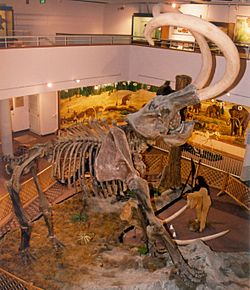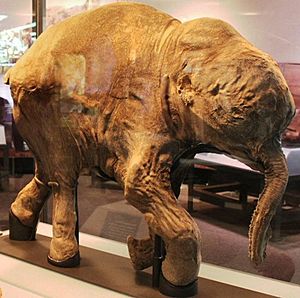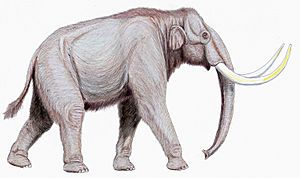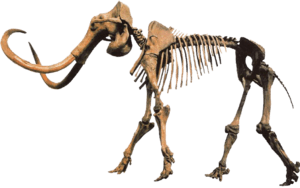Mammoth facts for kids
Quick facts for kids Mammoth |
|
|---|---|
 |
|
| Mount of a Columbian mammoth | |
| Scientific classification | |
| Kingdom: | |
| Phylum: | |
| Class: | |
| Order: | |
| Family: | |
| Genus: |
Mammuthus
|
Mammoths were huge, hairy elephants that lived a long time ago. They belonged to the group of animals called Mammuthus. These amazing creatures lived in places like Europe until about 4,500 years ago. They were very good at living in cold places.
Mammoths lived during the Pliocene and Pleistocene periods. During the Pleistocene, much of northern Europe was covered in ice and tundra. There were many ice ages, which helped mammoths spread across different lands. Early humans hunted mammoths using spears and hand axes. Scientists have even studied the DNA from their frozen bodies.
Contents
What Were Mammoths Like?
Just like modern elephants, mammoths were very big animals. The biggest known types could stand about 4 meters (13 feet) tall at the shoulder. They could weigh up to 8 tonnes (about 17,600 pounds)! Some very large male mammoths might have weighed even more.
However, most mammoths were about the same size as a modern Asian elephant. Asian elephants are usually 2.5 to 3 meters (8 to 10 feet) tall and weigh up to 5 tonnes. Both male and female mammoths had tusks. Their first small tusks grew when they were about six months old. These were replaced by permanent tusks when they were about 18 months old. These permanent tusks grew about 2.5 to 15.2 centimeters (1 to 6 inches) each year.
Scientists think mammoths had a gestation period of about 22 months. This means baby mammoths grew inside their mothers for almost two years before being born. They usually had one calf at a time. Their family life was probably similar to African and Asian elephants. Females likely lived in herds led by an older female, called a matriarch. Male mammoths often lived alone or in small groups after they grew up.
Scientists studied the remains of a baby mammoth. They found that a lot of fat helped it survive in very cold temperatures, even as low as -50 degrees Celsius (-58 degrees Fahrenheit). This fat also helped mammoths build strong muscles. This allowed them to fight off enemies and live longer lives.
What Did Mammoths Eat?
The diet of mammoths changed a bit depending on where they lived. But all mammoths ate similar types of plants. For example, the Columbian mammoth mainly ate grass. American Columbian mammoths also ate leaves from cacti, trees, and shrubs. Scientists learned this by studying mammoth poop and teeth. Like modern elephants, mammoths had special teeth called hypsodont molars. These teeth were good for grinding tough plants like grasses and trees. This helped them live in many different places.
The Mongochen mammoth ate herbs, grasses, larch trees, and shrubs. They might have also eaten alder trees. Scientists figured this out by looking at mammoth poop. It contained pollen from non-tree plants and moss spores.
European mammoths mostly ate a type of plant called C3 plants. Scientists found this out by looking at the chemical makeup of their teeth.
A baby mammoth named Lyuba was found in Siberia in 2007. Scientists think that baby mammoths, like baby elephants today, ate the poop of adult mammoths. This is because Lyuba's teeth were not fully grown enough to chew grass. Also, there were many spores of coprophilous fungi (fungi that grow on animal poop) in the pollen found near Lyuba's mother. These spores would spread to nearby plants, which the baby mammoth might have eaten. Eating poop, called coprophagy, might have helped baby mammoths get the right microbes in their stomachs to digest food.
Mammoths living in the Arctic during the last Ice Age mostly ate forbs, like Artemisia. Grasses were only a small part of their diet.
Why Did Mammoths Disappear?

The woolly mammoth was the last type of mammoth. Most woolly mammoths in North America and Asia, and all Columbian mammoths in North America, died out around the end of the last ice age. This was part of a big extinction event that affected many large animals. For a long time, people thought woolly mammoths disappeared from Europe and southern Siberia about 12,000 years ago. But new discoveries show some were still there about 10,000 years ago.
A small group of woolly mammoths lived on St. Paul Island, Alaska, until about 3750 BC. Even smaller mammoths on Wrangel Island survived until 1650 BC. This means some mammoths lived much longer than previously thought.
Scientists are still not sure exactly why mammoths died out. One idea is that the Earth started getting warmer about 12,000 years ago. This warming caused glaciers to melt and sea levels to rise. Forests grew where open grasslands used to be. This change in habitat might have made it harder for mammoths to find food and space. However, similar warming periods happened before without causing such big extinctions. So, climate change alone might not be the full answer.
Another important factor is the spread of advanced human hunters. Humans moved across northern Eurasia and the Americas around the time mammoths disappeared. This was a new development that might have played a big role.
It's a big debate whether mammoths died out because of climate or too much hunting by humans. As the climate warmed, the huge grasslands where mammoths lived, called the mammoth steppe, started to disappear. Mammoths moved to smaller, isolated areas before vanishing completely. Some scientists think that human hunters from the Late Paleolithic and Mesolithic periods might have hunted the last mammoth groups in Europe. There is some evidence that humans caused the extinction, but no definite proof.
One idea is that humans learned to live in the harsh northern climates where mammoths lived. If humans could survive there, they could hunt mammoths. Another idea is that mammoths caught a deadly disease. It's possible that a mix of climate change and human hunting led to their extinction.
Early humans, like Homo erectus, ate mammoth meat as far back as 1.8 million years ago. But this might have been from finding dead mammoths, not hunting them. Later humans show more signs of hunting mammoths. At a 50,000-year-old site in Britain, Neanderthals might have butchered mammoths. In Eastern Europe, sites from 15,000 to 44,000 years ago show that humans (probably Homo sapiens) built homes using mammoth bones. However, some experts say that marks on elephant bones can look like butchery marks, even if they were just caused by other elephants walking on them.
Scientists also have ideas about why mammoths died out in specific places. The mammoths on Saint Paul Island might have died out because the island became much smaller as sea levels rose. This made it too small to support enough mammoths. For the Wrangel Island mammoths, their genes show a big drop in variety. This might have made them less able to survive. Another idea for mammoths in Siberia is that many drowned. They might have fallen through ice while crossing rivers. This could explain why many bones are found along the Arctic Coast.
A smaller type of mammoth, called the pygmy mammoth, lived on the Channel Islands of California. These mammoths became smaller over time, a process called dwarfing. They were likely hunted by early Native Americans. Also, rising sea levels split the large island of Santa Rosae into smaller islands, reducing their habitat.
Related pages
Images for kids
-
Comparison of a woolly mammoth (left) and an American mastodon (right).
-
Paleolithic painting of mammoth from the Rouffignac Cave
See also
 In Spanish: Mamut para niños
In Spanish: Mamut para niños






